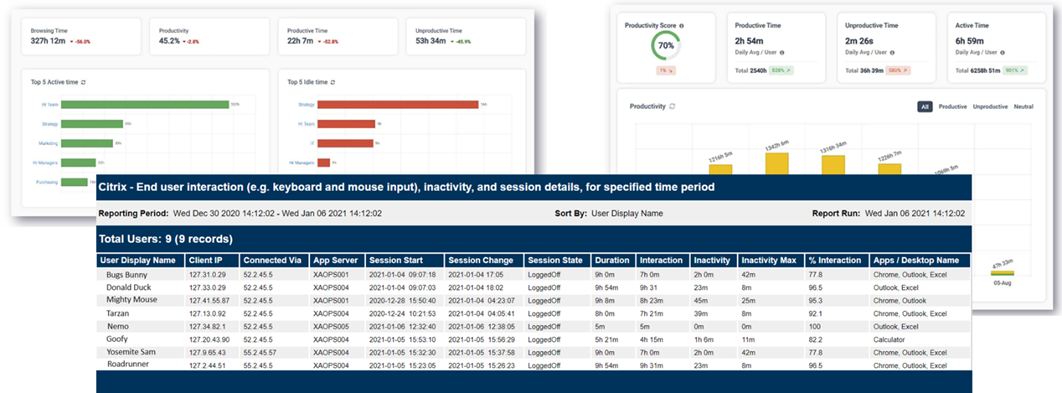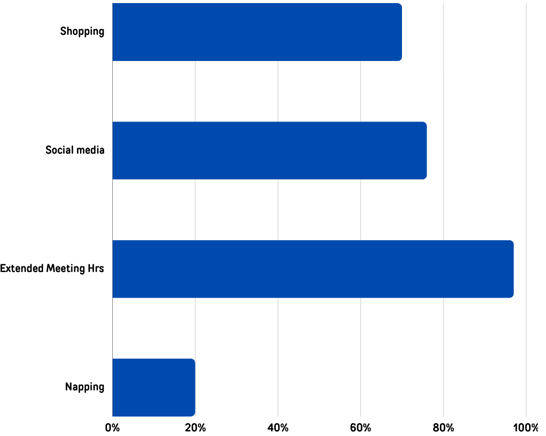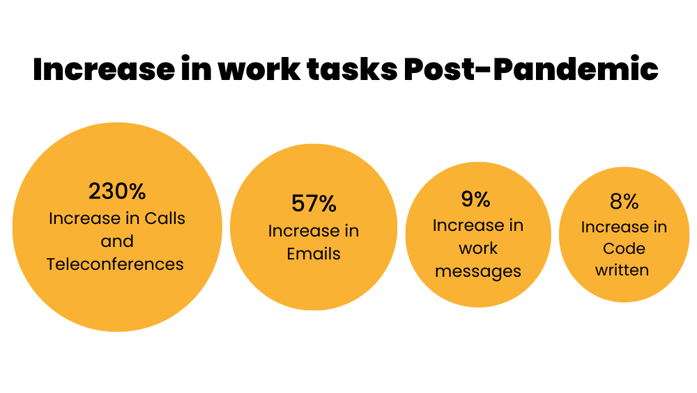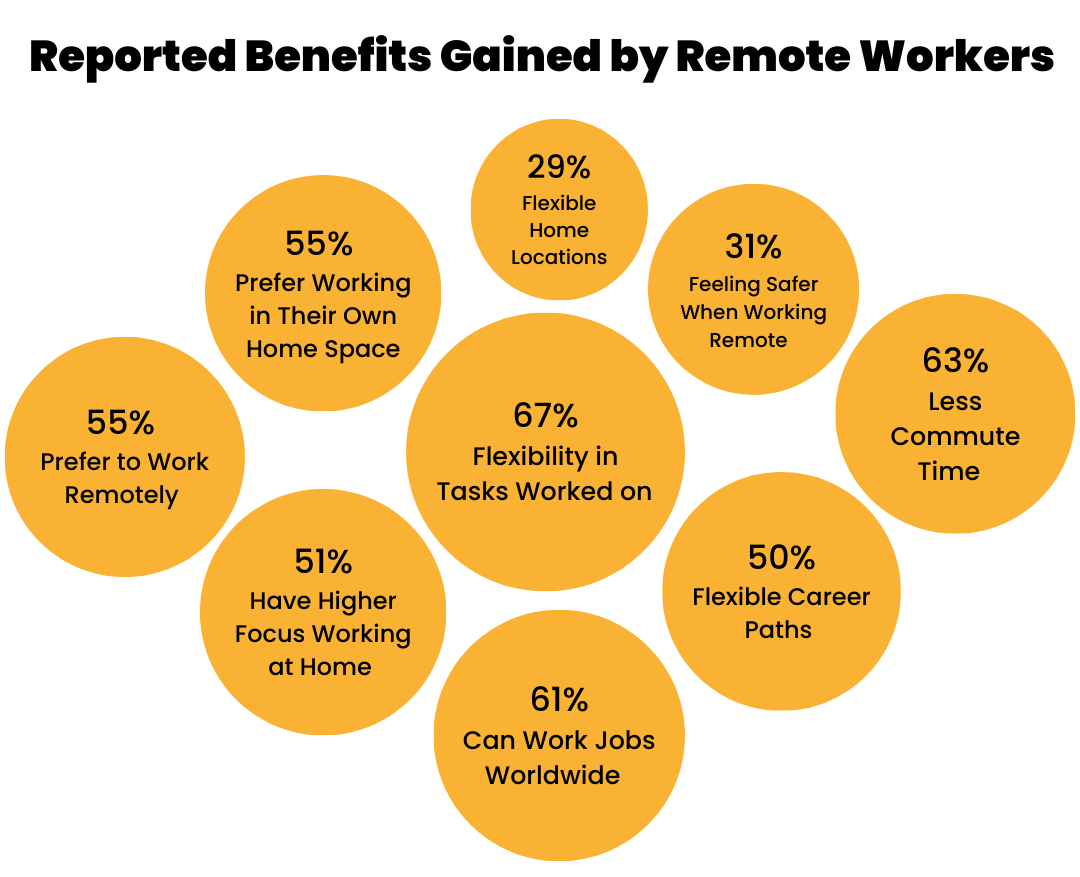
Executive Summary
The COVID-19 pandemic has triggered a significant shift in work dynamics, leading to a widespread adoption of remote work. Altanora's report delves into the multifaceted landscape of remote work, drawing insights from our own internal data collected on over 250,000 monitored and managed endpoints, from diverse studies and surveys conducted across various industries.
1. Productivity Perceptions
1.1 Future Forum's Survey: Unlocking Remote Productivity
Employees proclaim a staggering 47-65% (depending on industry) surge in perceived productivity and a remarkable 53% boost in focus during remote work. Productivity statistics gathered through platforms such as Altanora's Monitoring as a Service (MaaS) suggest that the actual increase in productivity is actually closer to 15-23%.
Extrapolations (industry and organization specific) broadly show that remote worker engagement on average is up.
Active Time:
- 55% of Remote Workers report working more hours than on-site workers.
- 43% of Remote Workers report working more than 40 hours per week.
1.2 Employer Skepticism: Navigating Confidence in a Virtual World
Despite these claims, employers harbor skepticism, with 85% having limited confidence in their workforce’s productivity. Adoption of Altanora’s Monitoring as a Service solutions support that notion, with 48% of our clients resorting to monitoring software to help validate their employee’s worktime.
Our platform allows firms to measure employee activity time and work-based application engagement so that organizations can get a true sense of their employees activities. Note that productivity is not always reflected as a 1:1 ratio between hours worked versus input/output. However, these tools help identify the low performers so that organizations can invest in their key contributors.
Know when your employees log in, take coffee/smoke breaks or are doing their Christmas sopping online.
Data collected from our customizable monitoring platforms include:
- Session Start/End Time
- Session Duration
- Interaction: During Session
- Inactivity: Time away from computer
- % of Work Time Interacting
- Apps Running
This allows organizations to create custom productivity profiles/reports tailored to their organizations.
- Productivity Scores: Custom
- Corporate Averages per Metric
- Productivity Alerts:
- Ex. 30 min. for lunch is okay, but flagged if it surpasses 2 hours.
- Flag unauthorized software use such as Amazon, TikTok, Fortnite, eBay, etc.

2. Remote Work Trends
2.1 Attrition Rates: Reshaping the Workforce Landscape
Remote work has not only reshaped how we work but has also led to a 35% reduction in attrition rates. Certain roles have experienced an 8% uptick in code output, emphasizing the dynamic transformation in productivity and job satisfaction associated with the adoption of remote work. These findings challenge the skepticism among traditionalist leaders regarding the productivity and commitment of remote workers, as research consistently indicates positive outcomes, including heightened employee performance and lower attrition rates.
This reduction in attrition also signifies a higher return on corporate human capital with productive employees staying longer. Global Workplace Analytics state that companies can save between $10,000 - $30,000 per employee due to longer retention, this does not consider the increased value of their overall output.
2.2 Extended Workday: The Transformation of Office Hours
The elimination of commutes, a major advantage of remote work, has not only brought about an 8.2% (48.5 minutes) extension to the average workday, but has also challenged traditional notions of office productivity.
In contrast, in-office studies surprisingly indicate that office work occupies only 36-39% of your employees' time, underscoring the dynamic shift in how professionals allocate their working hours in the evolving landscape of remote and hybrid work structures.

3. Employee Preferences
3.1 Future Work Ambitions: The Call for Fully Remote Jobs
A surprising 48% of employees express a desire for fully remote jobs in the future. Predictions indicate a 10% increase in pay for hybrid roles and a 20% increase for in-office positions. This signals a fundamental change in how individuals envision their work environments post-pandemic. Anticipated pay increases of 10% for hybrid roles and 20% for in-office positions reflect evolving compensation models.
However, we emphasize the importance of balancing productivity with employee well-being in the remote work context. Employers must navigate these changing expectations by offering competitive compensation and prioritizing work-life balance.
4. Impact on Well-being
4.1 Burnout Escalation: Unveiling the Toll of Remote Work
Future Forum Pulse's findings reveal a concerning 48% of employees and 53% of managers reporting burnout, a increase of 40%, with women experiencing burnout 32% faster than men. This surge in burnout, especially among women, emphasizes the need for thoughtful strategies that prioritize mental health and work-life balance in the evolving landscape of remote and hybrid work environments.
Executives however are feeling the brunt of the burnout as they struggle to manage and quantify the productivity of their remote workers. Since the pandemic executives report a 15% drop in job satisfaction, with 20% stating a decrease in work-life balance. All of this equates to an overall increase in 40% work-related stress. Although attrition rate among employees is dropping, it’s increasing among executives.
4.2 Cultivating Connection: A Vital Antidote to Burnout
Employees feeling disconnected from company culture are twice as likely to suffer burnout. This underscores the crucial role of fostering a sense of belonging in remote work environments, emphasizing the need for executives to prioritize initiatives that enhance connection and well-being in the evolving landscape of remote and hybrid work arrangements.

5. Challenges and Solutions
5.1 Productivity Paradox: Deciphering the Meeting Surge
Microsoft's survey highlights a productivity paradox with a 153% surge in weekly meetings, with an increase of overlapping meetings by 46%, with 42% reporting that they multi-task during their meetings, a concern echoed in a Citrix report.
Notably, 48% of business leaders turn to monitoring software to assess remote employee efforts, suggesting an avenue to address productivity concerns and potentially build trust over time. Currently, only 49% of employees express trust in their employers.
5.2 Navigating Distractions: Crafting a Disciplined Remote Environment
Altanora monitoring analytics confirm that employee distractions, lack of discipline, and self-control pose a serious threat to an organization’s productivity, and reported that social media (75%) and shopping (70%) were the major distractions monitored among their client’s end-user base.

6. Conclusion
6.1 Building Trust and Connections: The Imperative for Remote Success
Aligning perceptions with empirical data is identified as a key consideration for organizations navigating remote work dynamics.
Employers are urged to bridge the trust gap with their employees, in order to address burnout concerns, and invest in meaningful connections. Hybrid work models, supported by thoughtful policies and employee engagement initiatives, emerge as a strategic approach to optimize productivity and well-being in the evolving world of work.
6.2 Embracing Change: Navigating the New Work Paradigm
As the workforce adapts to new paradigms, understanding the nuances of remote work becomes crucial for organizational success. Altanora stands as a beacon in the revolution of remote work environments. As highlighted in this report, we understand the challenges organizations face, and in response, we are introducing customized offerings such as advanced productivity monitoring and modern workspace solutions, crafted to facilitate a seamless transition to remote work. Our innovative approaches are designed not only to instill confidence in employees but also to generate substantial cost and time savings.
Ultimately, working remotely is effective, but it has to be put into practice correctly, and it may not be the best situation for every employee or every business.







